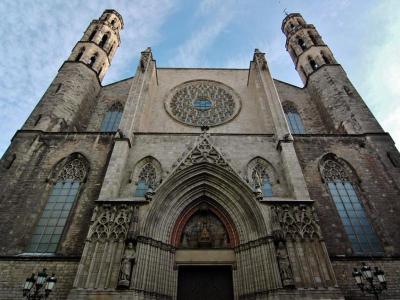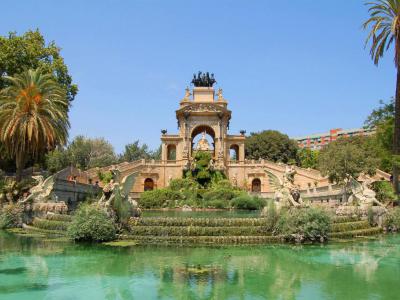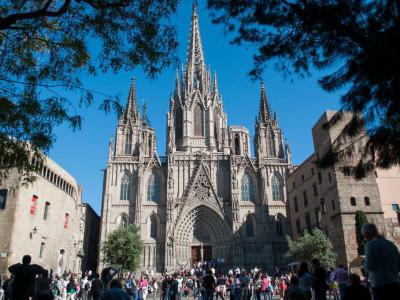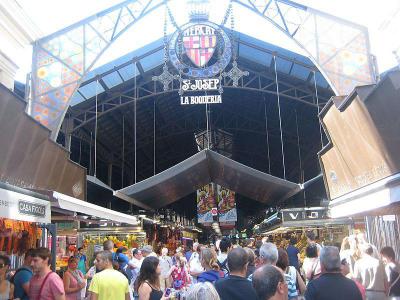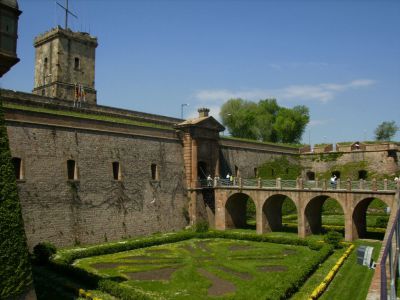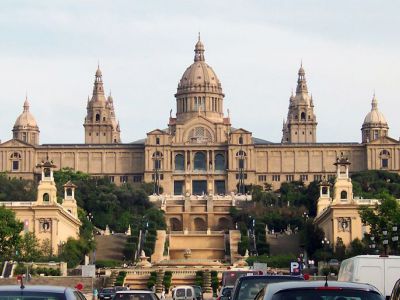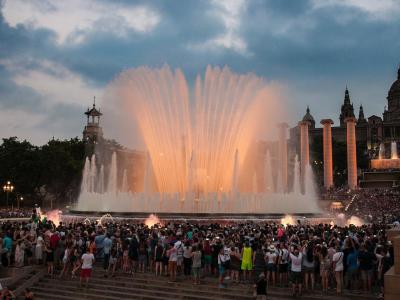Custom Walk in Barcelona, Spain by scraneconsulting2352 created on 2025-01-08
Guide Location: Spain » Barcelona
Guide Type: Custom Walk
# of Sights: 7
Tour Duration: 3 Hour(s)
Travel Distance: 7 Km or 4.3 Miles
Share Key: W86XY
Guide Type: Custom Walk
# of Sights: 7
Tour Duration: 3 Hour(s)
Travel Distance: 7 Km or 4.3 Miles
Share Key: W86XY
How It Works
Please retrieve this walk in the GPSmyCity app. Once done, the app will guide you from one tour stop to the next as if you had a personal tour guide. If you created the walk on this website or come to the page via a link, please follow the instructions below to retrieve the walk in the app.
Retrieve This Walk in App
Step 1. Download the app "GPSmyCity: Walks in 1K+ Cities" on Apple App Store or Google Play Store.
Step 2. In the GPSmyCity app, download(or launch) the guide "Barcelona Map and Walking Tours".
Step 3. Tap the menu button located at upper right corner of the "Walks" screen and select "Retrieve custom walk". Enter the share key: W86XY
1) Basilica de Santa Maria del Mar (Basilica of St. Mary of the Sea) (must see)
The Basilica of Saint Mary of the Sea is an outstanding example of early Catalan Gothic architecture, known for its uninterrupted lines and grace. Situated at the former water's edge, the edifice was constructed by skilled stonemasons who meticulously selected, fitted, and carved each stone sourced from the Montjuïc quarry, which had also supplied the sandstone for the 4th-century Roman walls. The number eight, symbolizing the Virgin Mary in medieval numerology, permeates every aspect of the basilica's design: the 16 octagonal pillars have a diameter of 2 meters and extend into rib vaulting arches at a height of 16 meters; the painted keystones at the apex of the arches are 32 meters above the floor; and the central nave is twice as wide as the lateral naves, measuring 8 meters each.
Despite enduring the destructive fires set by anarchists in 1936 during the rebellion, when numerous churches in Barcelona were targeted, Saint Mary of the Sea withstood the onslaught. Adorned with ornate side chapels and choir stalls at the time, the basilica burned for eleven days, nearly collapsing. It was later restored by a group of architects trained in the Bauhaus style following the Civil War, transforming it into an architectural marvel.
Why You Should Visit:
Remarkably grand and impeccably preserved; offers a lift to the roof, a small "art gallery", an intriguing crypt, beautiful stone carvings, a choir gallery, and the most astoundingly peaceful courtyard with a large pond. In addition, the surrounding area is dotted with charming local cafes offering outdoor seating, making it a delightful place to explore and wander.
Tips:
You have the option to participate in a guided tour that takes you up to the roof, providing a fascinating experience along with breathtaking views of Barcelona. Additionally, guided tours are available to explore areas that are usually restricted to the public, including the crypt. It's important to note that proper attire is required to enter these areas, as the guards at the entrance may refuse entry if the dress code is not followed.
Despite enduring the destructive fires set by anarchists in 1936 during the rebellion, when numerous churches in Barcelona were targeted, Saint Mary of the Sea withstood the onslaught. Adorned with ornate side chapels and choir stalls at the time, the basilica burned for eleven days, nearly collapsing. It was later restored by a group of architects trained in the Bauhaus style following the Civil War, transforming it into an architectural marvel.
Why You Should Visit:
Remarkably grand and impeccably preserved; offers a lift to the roof, a small "art gallery", an intriguing crypt, beautiful stone carvings, a choir gallery, and the most astoundingly peaceful courtyard with a large pond. In addition, the surrounding area is dotted with charming local cafes offering outdoor seating, making it a delightful place to explore and wander.
Tips:
You have the option to participate in a guided tour that takes you up to the roof, providing a fascinating experience along with breathtaking views of Barcelona. Additionally, guided tours are available to explore areas that are usually restricted to the public, including the crypt. It's important to note that proper attire is required to enter these areas, as the guards at the entrance may refuse entry if the dress code is not followed.
2) Parc de la Ciutadella (Citadel Park) (must see)
Originally built as a fortress to assert Madrid's military control over Barcelona, the Ciutadella is now the city's primary downtown park. It was established shortly after the War of the Spanish Succession in the early 18th century when Felipe V demolished around 1,000 houses to construct a fortress, barracks, and an open space known as the "glacis" between rebellious Barcelona and his artillery positions. The fortress walls were later dismantled in 1868, and the area was transformed into gardens designed by Josep Fontseré. In 1888, the park gained significance as the venue for the Universal Exposition, which propelled Barcelona into the spotlight as a truly European city. Today, the Ciutadella houses notable landmarks such as the Castle of the Three Dragons ("Castell dels Tres Dragons"), originally built as a café and restaurant for the exposition (now a botanical research center), the Catalan parliament, and the city zoo.
Both locals and tourists appreciate spending time in the Ciutadella. The park is well-equipped for picnics and public holidays, and offers various recreational activities such as jogging, cycling, and boating. Boats and bicycles are available for rent at a reasonable price. Entry to the park is free, making it a worthwhile destination to explore regardless of the duration of your stay in Barcelona.
Why You Should Visit:
To escape and relax without leaving the city centre!
Tip:
One of the prominent features within the park is the Cascada, a monumental fountain located in the northeast corner. It was designed by Josep Fontseré, the architect responsible for the park's conversion, with assistance from a young Antoni Gaudí, who was still a student at the time. The extravagant Baroque style of the Cascada foreshadows Gaudí's later flamboyant architectural designs. The ideal spot to admire the fountain is from the nearby open-air café-kiosk. In close proximity, there is also a small lake where visitors can rent rowing boats and enjoy a leisurely paddle amidst the ducks.
Both locals and tourists appreciate spending time in the Ciutadella. The park is well-equipped for picnics and public holidays, and offers various recreational activities such as jogging, cycling, and boating. Boats and bicycles are available for rent at a reasonable price. Entry to the park is free, making it a worthwhile destination to explore regardless of the duration of your stay in Barcelona.
Why You Should Visit:
To escape and relax without leaving the city centre!
Tip:
One of the prominent features within the park is the Cascada, a monumental fountain located in the northeast corner. It was designed by Josep Fontseré, the architect responsible for the park's conversion, with assistance from a young Antoni Gaudí, who was still a student at the time. The extravagant Baroque style of the Cascada foreshadows Gaudí's later flamboyant architectural designs. The ideal spot to admire the fountain is from the nearby open-air café-kiosk. In close proximity, there is also a small lake where visitors can rent rowing boats and enjoy a leisurely paddle amidst the ducks.
3) Catedral de Barcelona (Barcelona Cathedral) (must see)
The Cathedral of the Holy Cross and Saint Eulalia, commonly known as Barcelona Cathedral, is a delightful combination of a church, mini-park, and a house of prayer, offering a serene alternative to the renowned La Sagrada Família. As the seat of the Archbishop of Barcelona, it was primarily constructed between the 13th and 15th centuries.
The cathedral has a pseudo-basilica layout with five aisles and a raised high altar. It is dedicated to Saint Eulalia, a young martyr whose relics are housed in the white marble sarcophagus inside the crypt. An intriguing feature is the presence of 13 geese in the cloister, symbolizing Saint Eulàlia's age at the time of her death.
Inside, the cathedral showcases choir stalls adorned with the coats-of-arms of the Order of the Golden Fleece. The Chapel of the Holy Sacrament contains a cross associated with the 1571 Battle of Lepanto and has been reconstructed to hold the tomb of San Olegarius, a former bishop of Barcelona.
The cathedral’s origins trace back to an early Christian and Visigothic complex that was damaged during a Muslim attack on Barcelona in 985. It was replaced with a Romanesque church in 1046 before the current Gothic cathedral began construction in 1298. The cathedral took 150 years to complete yet its neo-Gothic façade, featuring gargoyles and other mythical creatures, was finished only in 1913. Unlike many other churches in Barcelona destroyed during the Civil War, this Gothic temple was spared.
An exemplary piece of Catalan Gothic architecture, emphasizing balanced proportions over verticality, the cathedral measures 93 meters long, 40 meters wide, and 28 meters high at its central nave, with bell towers reaching 54 meters and the central peak at 70 meters.
The Cathedral of Barcelona is also famous for giving rise to the unique Catalan tradition of "dancing egg." Observed during the feast of Corpus Christi (also known as the Solemnity of the Most Holy Body and Blood of Christ), this tradition features an egg balanced on a water fountain’s jet.
The cathedral's cloister contains a gift shop. Cellular phones have been banned from the Chapel of Lepanto and other chapels. While exploring the cathedral's interior, make sure to venture up to the lofty roof terrace. You will be rewarded with views of the cathedral's towers, pinnacles, cimborio, and the Cloister, and a 360-degree view of the city!
Tip:
Cathedral Visit (including Choir entrance + Access to the rooftop, Chapter hall, and Virtual Audio guide) is €9.00.
Cathedral + Museum (including Choir entrance + Access to the rooftop + Chapter hall + Virtual Audio guide + Museum) is €15.00.
The cathedral has a pseudo-basilica layout with five aisles and a raised high altar. It is dedicated to Saint Eulalia, a young martyr whose relics are housed in the white marble sarcophagus inside the crypt. An intriguing feature is the presence of 13 geese in the cloister, symbolizing Saint Eulàlia's age at the time of her death.
Inside, the cathedral showcases choir stalls adorned with the coats-of-arms of the Order of the Golden Fleece. The Chapel of the Holy Sacrament contains a cross associated with the 1571 Battle of Lepanto and has been reconstructed to hold the tomb of San Olegarius, a former bishop of Barcelona.
The cathedral’s origins trace back to an early Christian and Visigothic complex that was damaged during a Muslim attack on Barcelona in 985. It was replaced with a Romanesque church in 1046 before the current Gothic cathedral began construction in 1298. The cathedral took 150 years to complete yet its neo-Gothic façade, featuring gargoyles and other mythical creatures, was finished only in 1913. Unlike many other churches in Barcelona destroyed during the Civil War, this Gothic temple was spared.
An exemplary piece of Catalan Gothic architecture, emphasizing balanced proportions over verticality, the cathedral measures 93 meters long, 40 meters wide, and 28 meters high at its central nave, with bell towers reaching 54 meters and the central peak at 70 meters.
The Cathedral of Barcelona is also famous for giving rise to the unique Catalan tradition of "dancing egg." Observed during the feast of Corpus Christi (also known as the Solemnity of the Most Holy Body and Blood of Christ), this tradition features an egg balanced on a water fountain’s jet.
The cathedral's cloister contains a gift shop. Cellular phones have been banned from the Chapel of Lepanto and other chapels. While exploring the cathedral's interior, make sure to venture up to the lofty roof terrace. You will be rewarded with views of the cathedral's towers, pinnacles, cimborio, and the Cloister, and a 360-degree view of the city!
Tip:
Cathedral Visit (including Choir entrance + Access to the rooftop, Chapter hall, and Virtual Audio guide) is €9.00.
Cathedral + Museum (including Choir entrance + Access to the rooftop + Chapter hall + Virtual Audio guide + Museum) is €15.00.
4) Mercat de la Boqueria (La Boqueria Market) (must see)
Situated to the north of La Rambla and a few blocks south of Catalonia Square, the Market of Saint Joseph de La Boqueria is extremely busy no matter what time of day or season you come. Colloquially referred to simply as La Boqueria, this large public market is one of Barcelona's foremost tourist landmarks with a broad choice of goods on offer.
Initially, the area was an unofficial extension of the New Square market. The name "Boqueria" possibly originates from the Catalan word "boc" for goat, indicating a place for selling goat meat. Indeed, the first mention of La Boqueria, as the meat market near the old city gate, dates back to 1217. By 1470, it was renamed “pig market” and afterward remained known as a straw market, up until 1794.
In 1826, the market gained an official status, and in 1835, plans were made for a formal structure on La Rambla. Construction began in 1840 and the market officially opened the same year. After several modifications, the building was inaugurated in 1853. A new fish market was added in 1911, and the current metal roof was installed in 1914, giving the market its present look.
Despite the constant flow of visitors, the experienced vendors efficiently handle the crowds, and the market's spacious layout helps ensure an enjoyable shopping experience. La Boqueria offers a fantastic opportunity to explore traditional Catalan cuisine. Here, you can take yourself on a tapas tour, sample exquisite jamón with cheese, purchase the world's freshest saffron (sold in various-sized small boxes), and enjoy local seafood (except for Sundays and Mondays when no fish is sold), plus discover many other culinary delights.
Also, don't miss the chance to try the freshly cooked fish at Kiosko Universal (a sit-down counter and bar-like place) or indulge in the wide variety of olives and delicious fresh fruits. Venture deep into the market to find the best stalls and taste a little bit of everything – you won't be disappointed.
Tip:
Keep in mind that the area is known for pickpocketing incidents, so whether you're alone or with friends, it is recommended to be vigilant and keep a close eye on your belongings.
Initially, the area was an unofficial extension of the New Square market. The name "Boqueria" possibly originates from the Catalan word "boc" for goat, indicating a place for selling goat meat. Indeed, the first mention of La Boqueria, as the meat market near the old city gate, dates back to 1217. By 1470, it was renamed “pig market” and afterward remained known as a straw market, up until 1794.
In 1826, the market gained an official status, and in 1835, plans were made for a formal structure on La Rambla. Construction began in 1840 and the market officially opened the same year. After several modifications, the building was inaugurated in 1853. A new fish market was added in 1911, and the current metal roof was installed in 1914, giving the market its present look.
Despite the constant flow of visitors, the experienced vendors efficiently handle the crowds, and the market's spacious layout helps ensure an enjoyable shopping experience. La Boqueria offers a fantastic opportunity to explore traditional Catalan cuisine. Here, you can take yourself on a tapas tour, sample exquisite jamón with cheese, purchase the world's freshest saffron (sold in various-sized small boxes), and enjoy local seafood (except for Sundays and Mondays when no fish is sold), plus discover many other culinary delights.
Also, don't miss the chance to try the freshly cooked fish at Kiosko Universal (a sit-down counter and bar-like place) or indulge in the wide variety of olives and delicious fresh fruits. Venture deep into the market to find the best stalls and taste a little bit of everything – you won't be disappointed.
Tip:
Keep in mind that the area is known for pickpocketing incidents, so whether you're alone or with friends, it is recommended to be vigilant and keep a close eye on your belongings.
5) Castell de Montjuic (Montjuic Castle) (must see)
Perched at the very summit of Montjuïc, an 18th-century castle commands breathtaking views of the entire city and an expansive stretch of coastline. The initial fortress was constructed in 1640 and witnessed numerous battles during the War of the Spanish Succession in the early 1700s. Following the triumph of Felipe V, the Montjuïc fortress was reconstructed by the Bourbon rulers to maintain control over the local population. Infamous for its role as a prison and torture center, it continued to serve this purpose until after the Civil War, where notable Catalan leaders, including Lluís Companys, were imprisoned and executed.
While the castle once housed a military museum, the formal restoration of the castle to the Catalan authorities by the Spanish government in 2008 led to the transformation of the museum into a center dedicated to peace. Exhibits now chronicle the evolution of Montjuïc and the castle's tumultuous history. The castle's cable car ride and its dramatic location alone make it worth a visit. The views from the ramparts are truly magnificent, and below the castle walls, the panoramic Camí del Mar pathway stretches for one kilometer, leading to the Mirador del Migdia viewpoint. At this viewpoint, visitors can enjoy the pleasant outdoor bar named La Caseta, offering a great escape from the city and the added bonus of cool harbor views during the summer months.
Why You Should Visit:
Ideal for a lazy afternoon and quite fun to get to, taking the funicular railway first, then either the cable car (quite expensive but great views) or the bus (not so scenic but free on a T10 ticket).
Tip:
If you prefer to climb by foot, be prepared for a considerable amount of stair climbing, so please wear sturdy and comfortable shoes.
While the castle once housed a military museum, the formal restoration of the castle to the Catalan authorities by the Spanish government in 2008 led to the transformation of the museum into a center dedicated to peace. Exhibits now chronicle the evolution of Montjuïc and the castle's tumultuous history. The castle's cable car ride and its dramatic location alone make it worth a visit. The views from the ramparts are truly magnificent, and below the castle walls, the panoramic Camí del Mar pathway stretches for one kilometer, leading to the Mirador del Migdia viewpoint. At this viewpoint, visitors can enjoy the pleasant outdoor bar named La Caseta, offering a great escape from the city and the added bonus of cool harbor views during the summer months.
Why You Should Visit:
Ideal for a lazy afternoon and quite fun to get to, taking the funicular railway first, then either the cable car (quite expensive but great views) or the bus (not so scenic but free on a T10 ticket).
Tip:
If you prefer to climb by foot, be prepared for a considerable amount of stair climbing, so please wear sturdy and comfortable shoes.
6) Museu Nacional d'Art de Catalunya / MNAC (National Art Museum of Catalonia) (must see)
An essential destination for visitors to Barcelona, offering a splendid setting that showcases a thousand years of Catalan art, the magnificent Palau Nacional, originally constructed for the 1929 International Exhibition, has been the home of the city's most significant art collection since 1934. For those unfamiliar with the museum, deciding where to begin can be challenging; however, if you have limited time, it is recommended to focus on the medieval collection, which is divided into two main sections: one dedicated to Romanesque art and the other to Gothic art. During these periods, Catalan artists were at the forefront of the art scene in Spain.
The museum takes great pride in its collection of Romanesque frescoes, which were carefully removed from churches in the Catalan Pyrenees and presented in a reconstructed version of their original settings. Additionally, the MNAC houses an unparalleled collection of 19th- and 20th-century Catalan art, with the exception of works from the 1950s onwards. The museum's collection excels in "modernista" and "noucentista" painting and sculpture, the two predominant artistic movements of that era. Moreover, visitors can explore intriguing exhibits on topics such as "modernista" interior design, avant-garde sculpture, and historical photography.
To fully appreciate the exhibits, it is advisable to plan for multiple visits as tickets are valid for 2 days. The museum's website offers a convenient "create your own itinerary" feature, helping you maximize your experience. Additionally, blockbuster exhibitions and special shows based on the MNAC's extensive archives are highly popular, although they may require separate ticket purchases.
Why You Should Visit:
An absolutely magnificent museum, newly updated and modernized for the contemporary tourist.
Reasonably priced; plenty of lifts/stair lifts/toilets, and comfortable leather sofas dotted here and there for when your feet ache.
Tip:
Not only does the on-site restaurant offer a breathtaking view of Montjuïc, but it also provides excellent value for the price.
Make sure not to miss the rooftop for an even more spectacular panorama.
The museum takes great pride in its collection of Romanesque frescoes, which were carefully removed from churches in the Catalan Pyrenees and presented in a reconstructed version of their original settings. Additionally, the MNAC houses an unparalleled collection of 19th- and 20th-century Catalan art, with the exception of works from the 1950s onwards. The museum's collection excels in "modernista" and "noucentista" painting and sculpture, the two predominant artistic movements of that era. Moreover, visitors can explore intriguing exhibits on topics such as "modernista" interior design, avant-garde sculpture, and historical photography.
To fully appreciate the exhibits, it is advisable to plan for multiple visits as tickets are valid for 2 days. The museum's website offers a convenient "create your own itinerary" feature, helping you maximize your experience. Additionally, blockbuster exhibitions and special shows based on the MNAC's extensive archives are highly popular, although they may require separate ticket purchases.
Why You Should Visit:
An absolutely magnificent museum, newly updated and modernized for the contemporary tourist.
Reasonably priced; plenty of lifts/stair lifts/toilets, and comfortable leather sofas dotted here and there for when your feet ache.
Tip:
Not only does the on-site restaurant offer a breathtaking view of Montjuïc, but it also provides excellent value for the price.
Make sure not to miss the rooftop for an even more spectacular panorama.
7) Font magica de Montjuic (Magic Fountain of Montjuic) (must see)
One of Barcelona's most spectacular attractions, this engineering marvel was constructed by Carles Buïgas (1898–1979) for the 1929 International Exhibition. The Art Deco fountain, a feat that required the efforts of 3000 individuals, enchants spectators with its synchronized water jets that dance to the rhythm of music, creating a symphony of light and sound. While the themes of the shows may vary, they often culminate in a captivating rendition of the popular duet "Barcelona" by Montserrat Caballé and Freddie Mercury, famously performed during the 1992 Olympics.
Standing behind the Magic Fountain are four columns originally erected by the Modernista architect Puig i Cadafalch at the turn of the 20th century. These columns, designed to symbolize the stripes on the Catalan coat-of-arms, were tragically destroyed in 1928 as part of a prohibition on Catalan symbols. However, they have been painstakingly rebuilt and now serve as a potent symbol of Catalan pride, reclaiming their significance.
The optimal time to visit is just before nightfall, prior to the commencement of the magical display. Each day, thousands of people gather around, finding a seat on the numerous steps that lead up to the MNAC museum, and relishing in the opportunity to witness the sunset from the vantage point of Montjuic mountain, beneath which the fountain resides. The show lasts approximately 10-15 minutes and is entirely free to enjoy, inviting visitors to immerse themselves in its ambiance.
Why You Should Visit:
Good (free) entertainment!
Tip:
Arrive at least 45 minutes in advance to secure a favorable spot, as the area tends to become quite congested. Feel free to bring along your favorite food and beverages to enjoy during the show.
Standing behind the Magic Fountain are four columns originally erected by the Modernista architect Puig i Cadafalch at the turn of the 20th century. These columns, designed to symbolize the stripes on the Catalan coat-of-arms, were tragically destroyed in 1928 as part of a prohibition on Catalan symbols. However, they have been painstakingly rebuilt and now serve as a potent symbol of Catalan pride, reclaiming their significance.
The optimal time to visit is just before nightfall, prior to the commencement of the magical display. Each day, thousands of people gather around, finding a seat on the numerous steps that lead up to the MNAC museum, and relishing in the opportunity to witness the sunset from the vantage point of Montjuic mountain, beneath which the fountain resides. The show lasts approximately 10-15 minutes and is entirely free to enjoy, inviting visitors to immerse themselves in its ambiance.
Why You Should Visit:
Good (free) entertainment!
Tip:
Arrive at least 45 minutes in advance to secure a favorable spot, as the area tends to become quite congested. Feel free to bring along your favorite food and beverages to enjoy during the show.
